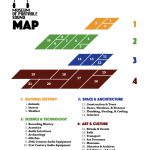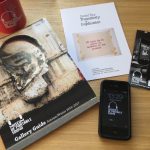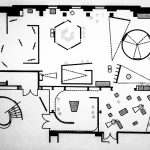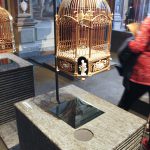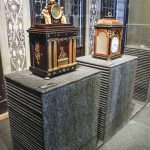Towards a more sonically inclusive museum practice: a new definition of ’the ‘sound object
Article DOI: https://dx.doi.org/10.15180/170805
Abstract
As museums continue to search for new ways to attract visitors, recent trends within museum practice have focused on providing audiences with multisensory experiences. Books such as 2014’s The Multisensory Museum present preliminary strategies by which museums might help visitors engage with collections using senses beyond the visual. In this article, an overview of the multisensory roots of museum display and an exploration of the shifting definition of “object” leads to a discussion of Pierre Schaeffer’s musical term objet sonore – the “sound object”, which has traditionally stood for recorded sounds on magnetic tape used as source material for electroacoustic musical composition. A problematic term within sound studies, this article proposes a revised definition of “sound object”, shifting it from experimental music into the realm of the author’s own experimental curatorial practice of establishing The Museum of Portable Sound, an institution dedicated to the collection and display of sounds as cultural objects. Utilising Brian Kane’s critique of Schaeffer, Christoph Cox and Casey O’Callaghan’s thoughts on sonic materialism, Dan Novak and Matt Sakakeeny’s anthropological approach to sound theory, and art historian Alexander Nagel’s thoughts on the origins of art forgery, this article presents a new working definition of the sound object as a museological (rather than a musical) concept.
Keywords
anthropology, collection, culture, curation, multisensory, museology, objects, objet sonore, Pierre Schaeffer, sound
Introduction
https://dx.doi.org/10.15180/Until recently, the museum or gallery was predominantly a unisensory visual experience.
If a sound liberation is to occur it will mean confronting the meaning(s) of the noise we produce, challenging the context of its reproduction and transmission, and engaging in an active, rather than passive, investigation of sound recording technologies.
… [C]urator and anthropologist Gloria Cranmer Webster tells a story about an encounter she had with the Canadian anthropologist Wilson Duff in the early 1970s. Duff came upon her one day while she was working in the store room of the old University of British Columbia Museum of Anthropology. “He picked up a raven rattle, brought it over to me and asked, “Isn’t it beautiful?” “Yes,” I replied, and went back to my typewriter. He then asked, “But how do you read it?” Impatiently I said, “Shit, Wilson, I don’t read those things, I shake them.”
In chapter 14 of The Palgrave Handbook of Contemporary Heritage Research, Noel Lobley, formerly of the Pitt Rivers Museum, provides case studies of two projects – one with the International Library of African Music in 2007 and the Pitt Rivers Museum at Oxford in 2012 – wherein he organised the display of archival recordings via local community distribution channels outside museum walls, bringing the sounds directly to the communities most able to benefit from listening to them. In this way, the historical descendants of the people who were originally recorded were able to help gather further information about the original recordings through a process he refers to as “sonic elicitation” (2005, pp 234–47).
In his chapter, Lobley routinely refers to these archival recordings as “sound objects”, a term originally proposed in 1966 by the French experimental composer Pierre Schaeffer in his publication Traité des objets musicaux [Treatise on Musical Objects]. L”objet sonore – the “sound object” – as a term, would go on to impact the worlds of musical composition and sound art for decades. However, Lobley doesn’t use the term in the Schaefferian sense – he uses it to refer to multiple kinds of recordings as collected by museums, and never explicitly defines the term “sound object”. My own further research has also not produced evidence that this term has ever been defined within a museological context.
As an artist and curator, my practice seeks to create a dialogue between the disciplines of sound studies and museology. My work as an artist has long sought to make connections between sight and sound, and my preoccupation with these two senses has continued as I have begun work as an independent museum practitioner opening my own museum, The Museum of Portable Sound (MOPS), an institution which seeks to collect and exhibit sound as “an object of culture and human agency”, as influenced by an emerging anthropological view on sound (Novak and Sakakeeny, 2015, p 5). In my curatorial work for this project, it has been useful for me to think of sounds as objects, something that is now nearly antithetical to most opinions within the sound studies world. However, it has proven extremely useful in my own museum practice, allowing me to present my own field recordings as examples of sonic culture across multiple disciplines in a format that echoes traditional object-based museum practice (see Figure 1). Based upon the feedback I have received from museum professionals and museologists who have visited MOPS (at the time of writing there have been more than five hundred visitors), thinking of sound in this way seems likely to prove useful for a discipline which thinks in terms of objects, and is itself in the midst of a disciplinary turn towards the multisensory within its own practice, as will be explored further below.
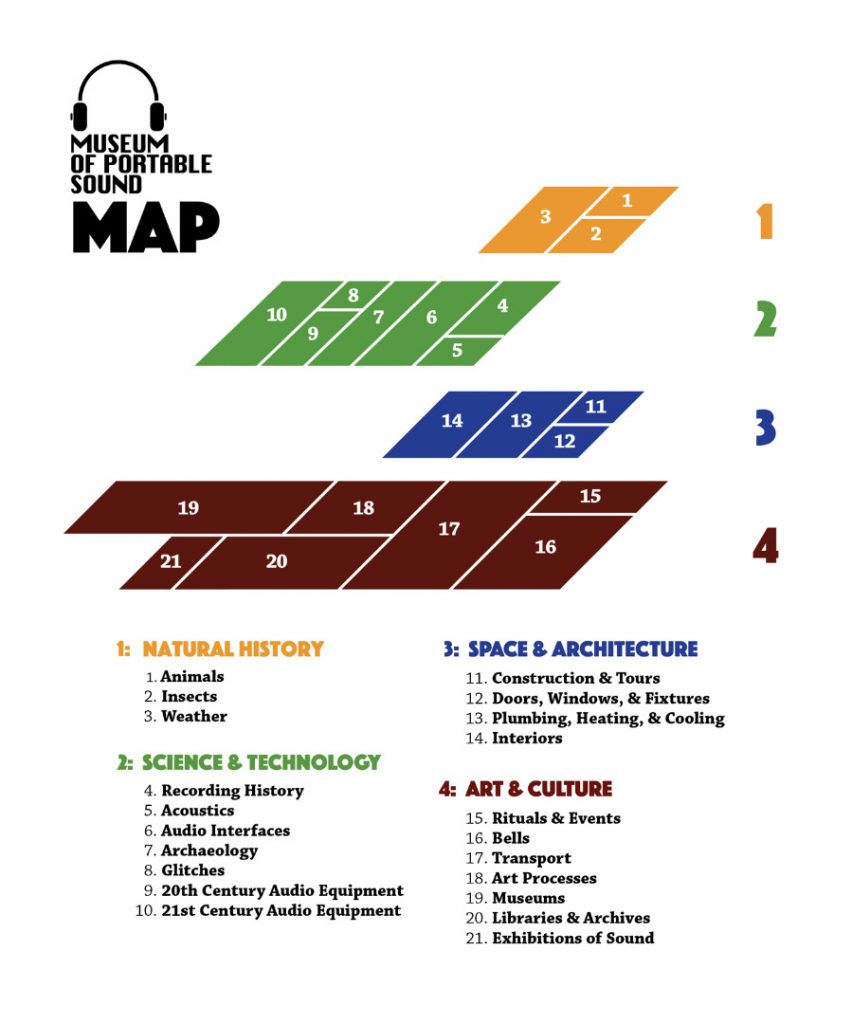
Rather than construct a new term for sound as a collectable material within a museum context, this article will instead discuss the preliminary results of my own curatorial practice’s use of Schaeffer’s term as a strategy for the curation of sounds as objects of culture, something that might eventually prove useful outside my own practice for a variety of museum types; I view sound as not being the sole domain of sound art and contemporary art museums, but as a component of natural and cultural heritage that could be accessible to museums of multiple types. One type of museum that I deliberately avoid engaging with in this article, however, is the music museum. While music museums are devoted to the display of objects that make sound, my interest in developing the notion of a museological sound object finds its focus in what I can only refer to (problematically) as non-musical sound. Music is, in my opinion, a specialised type of sound with a vast amount of cultural bias and pre-conceived notions towards what that sound is, why it is made, and how it is received. Although I believe musical sound should eventually be included within my notion of a museological sound object, for the moment I have chosen to focus on sounds that are not traditionally thought of as music in order to explore the idea of sounds beyond their more commonly acceptable forms within the museum world’s idea of intangible cultural heritage – those of music and oral traditions. Indeed, many of the highest-profile sound-related activities in museums tend to focus on musical sound. One of the most visible projects in this regard is the ‘Reel 2 Real’ series at the Pitt Rivers Museum at Oxford, which presents field recordings of traditional songs and other types of music within the museum context, including live presentations of the field recordings remixed DJ-style; this approach presents musical sounds in a musical format, as a musical backdrop to a candle-lit walk through the galleries. While exciting, engaging and ground-breaking, this programme benefits from pre-conceived ideas about musical sounds and how those are to be delivered to and received by an audience. The sounds I have most often collected, and have included in my own museum, are primarily related to industrial heritage: sounds of human-made machines, or human interactions with a space or place in ways that are not particularly musical or spoken. While the lack of discussion of music museums may be perceived as an oversight, I instead view it as a feature: by focusing on so-called non-musical sound instead of music, my intention is to bring attention to sounds that are often ignored, yet which I believe are as culturally relevant as music. I feel I have been able to devise new exhibition strategies for these types of sounds that have more in common with the display of material culture than with the display of aestheticised sound, i.e. music.
During the course of my research, I have discovered that there exists a great deal of theoretical tension between sound studies and museology (academically known as museum studies). Contemporary sound studies seek to break down categories and labelling in order to create dialogues between traditionally separate practices, such as music, sound art, film sound, radio art, history, anthropology, etc. Museum studies derives from the nineteenth-century Enlightenment tradition, where object-based categorisation and labelling has been an intrinsic part of the discipline for centuries. Not only that, museum studies takes a holistic approach with the wide variety of institutions that can be described as a ‘museum’ – studying anything from art galleries and natural history museums to institutions dedicated to science, archaeology, anthropology, and even zoos and botanical gardens. As an artist and curator on the border between these two fields, it has proven to be a delicate balancing act to satisfy the demands of both of these worlds simultaneously, and this tension will no doubt become apparent to readers of this article who hail from one or the other discipline.
Having said that, it is necessary to first provide a brief survey of historical and contemporary contexts within sound studies and museology before diving in to the re-definition of an established term.
The multisensory roots of the museum
https://dx.doi.org/10.15180/170805/002Although museums have been considering a transition in focus from objects to experience for nearly two decades (Weil, 1999, p 229; Hein, 2000, pp 1–16), the discipline of museology has only in recent years begun to consider multisensory interaction’s impact upon the visitor experience beyond the typical exhibition design focus on visual and textual display (Edwards et al, 2006; Levent et al, 2014). Since a museum’s practice is usually defined by the institution’s mission statement – which in turn typically defines the institution’s subject matter by highlighting audience needs (Gurian, 2005, p 54) – it is my belief that, by exhibiting sounds that museums themselves have collected, museums might be able to both engage audiences on another sensory level (thereby experimenting with the latest trends in museological theory) and better fulfil their missions of educating the public, by exposing them to the increasingly scrutinised culture of sound. This belief, while becoming increasingly popular among museum practitioners, is simultaneously a radical break from tradition and a return to the discipline’s very roots.
The concept of the museum – institutions dedicated to collecting, preserving, and displaying the objects of culture – can be dated back to the ancient world, when large-scale research institutions such as the museum within the Library of Alexandria functioned as integral parts of dedicated learning complexes. However, museums of this time tended to focus their research activities on literature more than objects, as one noted satirist of the time, Timon of Philus, once declared, ‘In populous Egypt many cloistered bookworms are fed, arguing endlessly in the chicken coop of the Muses’ (Barnes, 2004, p 62). The contemporary notion of what we now refer to as museums dates back to at least Quiccheberg’s sixteenth-century treatise on Wunderkammers and Kunstkammers, the first published attempt at defining a methodology by which museums should be organised, which acted primarily as a guide for organising the collections of elite noblemen (Quiccheberg, 2013, p 3). These privately owned collections eventually evolved into significantly larger public institutions dedicated to enriching the knowledge of (supposedly) people of all classes, commencing with the seventeenth-century opening of the Ashmolean Museum in Oxford (Abt, 2006, p 115). The opening of the British Museum and the Louvre in the eighteenth century ushered in the age of the so-called ‘universal museums’ – institutions that aspire to make a ‘universal’ survey of culture (Duncan and Wallach, 2012, p 50; Sloan and Burnett, 2004), attempting the impossible mission of following Quiccheberg’s treatise by assembling massive collections that are intended to categorise and display all of human knowledge (Curtis, 2012, p 74).
It is significant to note that the Wunderkammers and cabinets of curiosities of the sixteenth and seventeenth centuries incorporated a multisensorial approach to the interpretation of the objects in the collections (Edwards et al, 2006, p 18). These early museums aligned themselves with contemporary thinkers such as the seventeenth century scientist Robert Hooke, who suggested that proper investigation of an object included determining its:
Sonorousness or Dulness. Smell or Taste…Gravity, or Levity. Coarseness, or Fineness. Fastness, or Looseness. Stiffness, or Pliableness. Roughness, or Brittleness. Calmness, or Slipperiness.
(Howes and Classen, 2013), p 18
Early museumgoers – chiefly made up of princes and other nobles – were subsequently allowed by Wunderkammer curators to engage with displayed objects in multisensory ways, actively partaking in not only the sights of the objects, but their smells, touch, and sounds as well (Howes and Classen, 2013, p 18).
Museum attitudes towards the multisensory began to change as they opened for public access in the nineteenth century. A gradual shift occurred within museum practice towards a particularly western, colonial, and ultimately modern visual approach to the transmission of knowledge (Edwards et al, 2006, p 18), depriving the public of the Wunderkammers’ multisensorial approach to learning. The newly public museums of the nineteenth century stopped being perceived as merely research facilities and instead became shrines to knowledge, requiring ‘quiet and passive spectators to complete [their] purpose’ (Bennett, 2013, p 16). This encouragement of silent contemplation was no doubt partially a result of public museum owners – in most cases, local governments – viewing these institutions as providers of educational and behavioural training to the lower classes who, through their exposure to museums, would become well-versed in the knowledge of the world’s culture while reinforcing their identity as submissive, self-managed loyal subjects (Bennett, 1995, p 23). Public museums also became silent during an era when the elite within the UK began to view silence as necessary to facilitate creative, technical thought and the acquisition of knowledge. Several prominent authors of the time, including Charles Dickens, penned missives about their disdain for the noises of modernity – particularly the sounds generated by immigrants who worked as organ grinders and other types of street musicians in Victorian London (Picker, 2003, pp 60–61).
Recent trends within twenty-first-century museum practice, such as the ‘participatory museum’/ ‘Museum 2.0’ movement championed by American museum professional Nina Simon, have sought to encourage visitor participation within the museum experience, allowing visitors to have an active voice within curatorial choices (Simon, 2010, p 33) and calling for museums to listen to their visitors – an overturning of this tradition of silent audiences. Museum 2.0’s innovative strategy has worked to varying degrees, with some museums opening up their curatorial choices to public vote (Gamerman, 2014), or even redesigning their entire permanent collection displays in an attempt to be more visitor-friendly (Penney, 2009, p 35). With museums willing to go to such dramatic lengths as a complete redesign in order to simply be perceived as ‘listening to audiences’, it becomes easier to understand why writers such as Brian O’Doherty have been declaring that museums are in a state of crisis since at least the advent of Modernism (O’Doherty, 1972).
As museums in the twenty-first century have begun grappling with new methods by which to engage with their audiences, philosophers and theorists have also begun grappling with new notions of something central to museums: objects. The emergence of object-oriented ontology within contemporary philosophy has radically redefined the relationship between objects and humans, in the process expanding the definition of objects to include colossal things like entire galaxies, or ephemeral things like ideas. As my work involves redefining sound as an object, it would appear that doing so within object-oriented ontology’s broader scope might be a temptation; however, to do so would imply an agreement with OOO’s ‘refus[al] to treat objects as constructions of humans’ (Bryant, 2011, p 18). It is my belief that this democratisation of objects and humans, while philosophically compelling, is fundamentally incompatible with the essence of museum practice as it exists today, a discipline based entirely upon humanity’s desire to collect, categorise and display objects for the education and entertainment of humanity. Perhaps object-oriented ontology may become the basis for a future museum practice, but for now even radically progressive attempts to move museum practice beyond the traditional power structures between museums, objects and visitors such as the afore-mentioned Museum 2.0 movement still rely upon the belief that objects exist at the behest of humanity. Subsequently, I feel compelled to acknowledge the existence of object-oriented ontology while simultaneously asserting that, for the time being at least, I find it most useful outside the realm of museum practice for the time being.
In recent years, museums have found themselves increasingly under the scrutiny of sound artists, especially field recordists. My own artistic research into the sonic experience of museums generates detailed sound maps of museum spaces. I visit each mapped museum as any other visitor would, conducting my work unannounced during regular public hours, on view but essentially in secret, recording the sounds that ‘naturally’ occur within museum spaces. These recordings unravel the stereotypical notion of a ‘silent’ museum (Kannenberg, 2016). Other museum-based recording projects, such as sound artist residencies like Aleks Kolkowski’s work at the Science Museum in London (personal communication, 11 December 2014) and Matt Parker’s ‘Imitation Archive’ at Bletchley Park (Parker, 2016) have involved large-scale recording sessions of the sounds generated by objects that are held within a museum’s physical object collections – projects that have accomplished important work in generating sonic material for future display opportunities.
To further explore the act of listening to sounds within a museum context, I have developed an experimental curatorial practice, establishing an institution – The Museum of Portable Sound – whose ‘galleries’ display digital audio files of my own field recordings of museums (as well as a broad range of other examples of sonic culture) on a single mobile phone (see Figure 2); the museum, although digital in nature, is not distributed online, but rather presented on an individual basis to visitors who make an appointment to listen to the museum along with me (Gray, 2017). The wide-reaching results of this curatorial experiment, to be published in the future, are at this point beyond the scope of the present article. However, my own thinking towards the project’s central conceit – that sounds can be collected and exhibited as objects of culture – has led to this article’s proposal for a new definition of the term ‘sound object’.
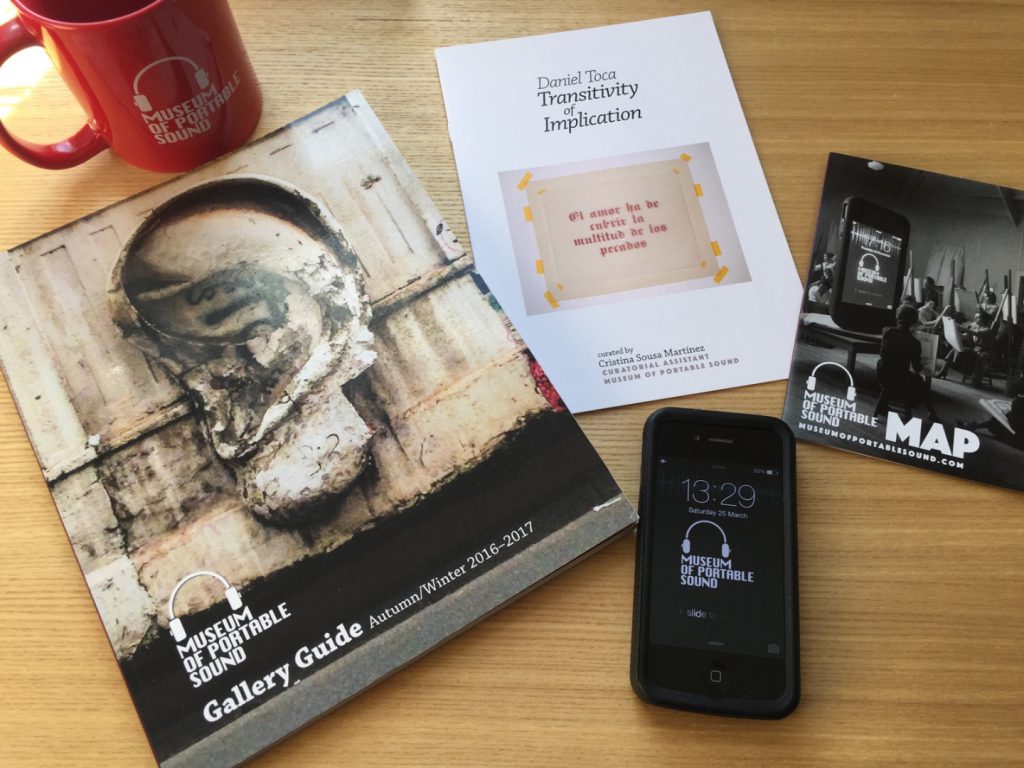
Resonance, wonder and authenticity
https://dx.doi.org/10.15180/170805/003One of the primary means through which museums engage with the attentions of their audiences is through what is referred to by Stephen Greenblatt as a sort of feedback loop of resonance – “the power of the displayed object to reach out beyond its formal boundaries to a larger world, to evoke in the viewer the complex, dynamic cultural forces from which it has emerged and for which it may be taken by a viewer to stand” – and wonder – “the power of the displayed object to stop the viewer in his or her tracks … to evoke an exalted attention” (Greenblatt, 1991, p 42). These heightened powers over the resonance and wonder experienced by audiences thought to be held by museum objects are derived from the aura of authenticity that surrounds them (Benjamin, 2007, p 221). Audiences feel in awe of museum objects because of their acceptance of the museum’s authority as an arbiter of the truth – without that, the viewer’s questions regarding an object’s origin, provenance and acquisition would counteract the resonance of the experience (Greenblatt, 1991, p 45).
These notions were, of course, developed based solely upon the visual experience of objects of material culture. While the ever-elusive definitive definition of the term “object” has long been a contentious exercise across multiple disciplines including philosophy (Adorno, 1997; Mallarmé quoted in Badiou, 2014), art history (Clark, 1998; Gell, 1998), and museology (Pearce, 1993; Gurian 2005; Conn, 2010; Dudley, 2010; Dziekan, 2012), to come to any conclusions about a single, universally accepted definition is beyond the scope of this article.
As discussed in The multisensory roots of the museum above, the collection and display of objects of material culture appear to be defining elements of the museum. I would suggest that these visual, tangible objects are not the only objects capable of functioning within the resonances generated by museum displays, particularly considering the initiative to preserve the world’s intangible cultural heritage established by UNESCO in 2003 that museums have been grappling with ever since (Alivizatou, 2016).
Contemporary sound art curation
https://dx.doi.org/10.15180/170805/004Art museums have made significantly more progress in the display of sounds (both non-musical and musical) as an object than their counterparts in the fields of natural history, anthropology and science, spurred on by the burgeoning interest in sound as a medium of art. Beginning with the Hayward Gallery’s Sonic Boom (Toop, 2000), these steps towards a prototypical “sonic blockbuster exhibition” have seen diverse curatorial strategies put forth for the display of sound art as museum objects in exhibitions such as: 2012’s A House Full of Music at the Mathildenhöhe Darmstadt (Beil et al, 2012); 2012’s Sound Art: Sound as a Medium of Art at ZKM in Karlsruhe (Weibel, 2017); 2013’s Soundings: A Contemporary Score at MoMA in New York (London et al, 2013); 2014’s Art or Sound at the Fondazione Prada in Venice (Celant, 2014); 2015’s Soundscapes at the National Gallery, London (Moore Ede and Noy, 2015); and 2016’s This Is A Voice at the Wellcome Collection, London (Currall and Muñoz, 2016).
A more detailed review of these exhibitions will eventually be required in order to determine what contributions, if any, these exhibitions have made towards the implementation of a more sonically inclusive museology, and remains outside the scope of the present article. At this stage, however, two of these exhibitions stand out as being particularly successful in their approaches to the display of sound art for different reasons.
The Wellcome Collection’s This Is A Voice presented sound within the context of the human voice, including a combination of scientific objects describing human anatomy related to vocalisation and hearing, alongside creative works of music, sound art, and multimedia, creating a dialogue between scientific and cultural approaches to the voice. According to the exhibition’s curator Bárbara Rodríguez Muñoz, in a presentation she gave in 2016 at the “Acoustics on Display” symposium at the Science Museum in London, she was attempting to explore the voice beyond linguistic terms, focusing on communication through melody and rhythm. Muñoz described an early intention of the exhibition’s designers to “work with sound … as a friend as opposed to an enemy, and to use it to create a narrative across the gallery space” (Currall and Muñoz, 2016). This led to a variety of architectural approaches that primarily kept the space open rather than attempting to compartmentalise sounds in isolated chamber-like spaces (see Figure 3). However, one of the most important strategies, according to Muñoz, was in managing visitor expectations by advertising the exhibition as an experience where visitors would be “surrounded by voices”, leading to an audience who was generally more prepared to listen to an exhibition than is usually the case.
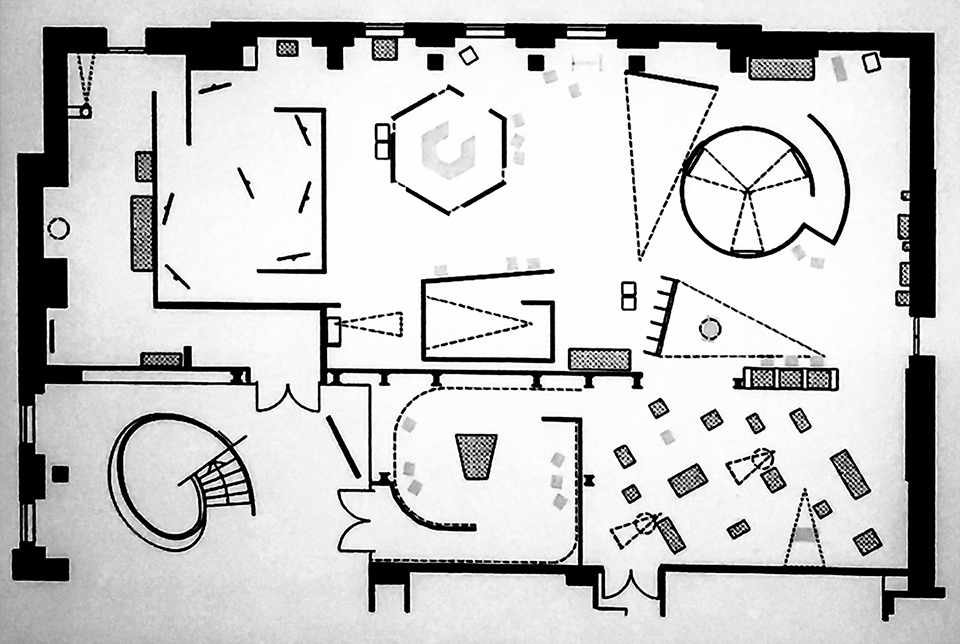
Setting aside the exhibition’s curatorial discretions that forego any pre-twenty-first-century contributions by non-western artists, Fondazione Prada’s Art or Sound appears to be the most successful of the above-mentioned exhibitions in terms of displaying sounds alongside their original sources, authentic historical physical objects. Several of the sculptures, instruments and decorative objects on display played their own sounds live into the gallery space and set up a tension between the sounds and their physical sources – which was the object: the sound or the material producing it? This type of display, while not perfect, approaches breaking new ground for the display of sounds as objects within a museological context. This success was the result of conceptual and technical aspects of the exhibition’s curation and design. The exhibition’s catalogue states that the sounding objects in the exhibition were treated with a quasi-musical intent, in the hopes that visitors would accept the sounds of multiple objects as parts of a whole rather than as intrusions upon each other. The exhibition’s installation included several sound-related design solutions, including cushioned plinths helping to isolate and absorb sounds (see Figures 4–6). As with any exhibition of sound taking place in a visual gallery space, there were inevitable areas of sonic conflict, but in terms of physical objects displayed as sounding objects, Art or Sound stands out as particularly successful in both concept and execution.
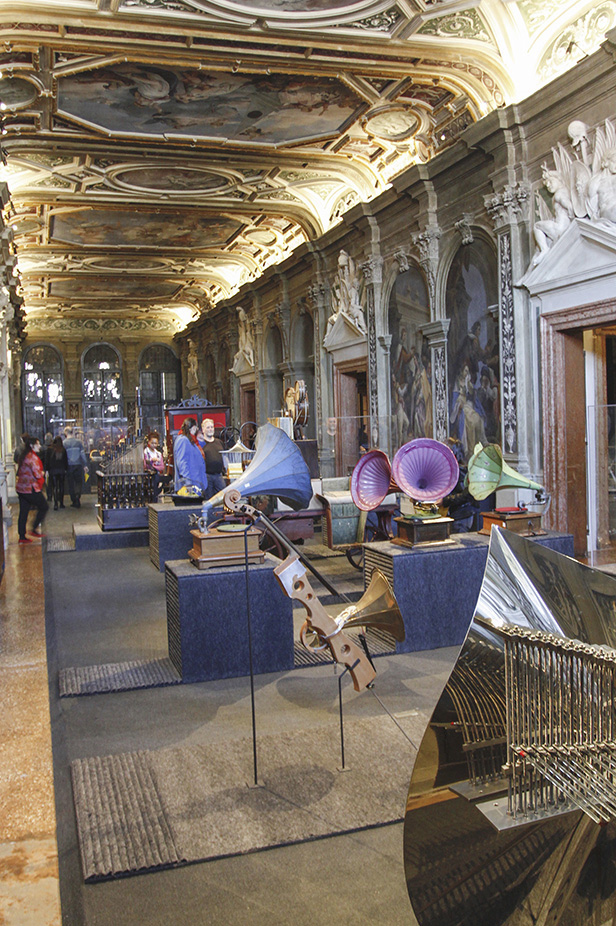
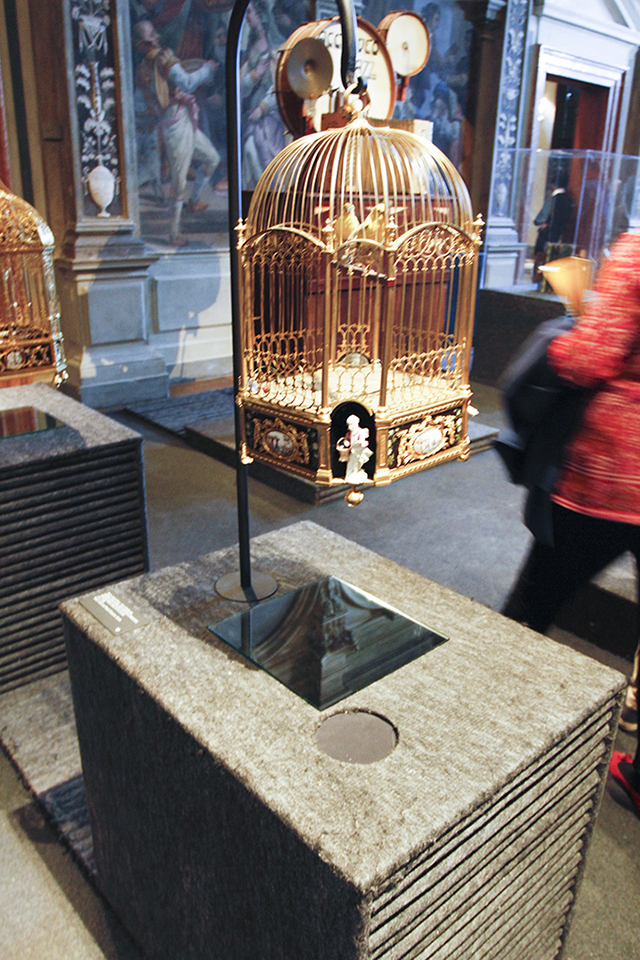
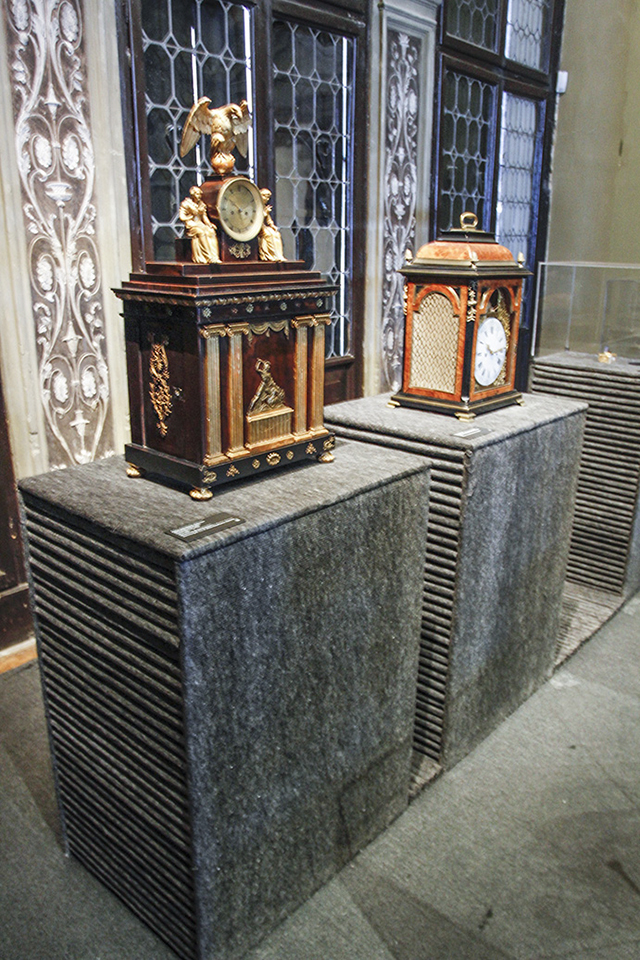
Listen to my own recordings of the exhibition on SoundCloud:
The presentation strategy in Art or Sound appears to align consistently with sound art theorist Christoph Cox’s call for a sonic materialism within aesthetics. Cox suggests that it is the intangible quality of sound that has misguidedly caused philosophers to regard sounds as “secondary attributes of the objects we see: the sound of a bird, the sound of an air conditioner” (Cox, 2011, p 156). If we remove the visual as our primary focus of the interpretation of sounds, however, it is possible to view sounds as distinct from their sources, and Cox’s thoughts on the subject are worth quoting here at length:
Visual objects persist through time and survive the alteration of their properties. (The door, for example, remains when it is painted a different colour.) By contrast, properties do not survive in this way. (The redness of the door does not survive its repainting.) In this respect, sounds appear to be much more akin to independently existing objects, since they survive changes to their qualities. A sound that begins as a low rumble may become a high-pitched whine, while remaining a single sound. In such an occurrence, the object that produces it (a car, for example) does not lose one sound and gain another. The sound remains what it is throughout, though its sensible qualities change … [W]e can experience a sound without experiencing its source, and the source without the sound. So while sources generate or cause sounds, sounds are not bound to their sources as properties. Sounds then, are distinct individuals or particulars like objects … This is precisely what – albeit in the idealist language of phenomenology – Pierre Schaeffer … aimed to show in his analysis of the objet sonore.
(2011), p 156 [emphasis in original]
Cox is not, however, arguing for the consideration of sound itself as an object. While arguing for a more materialist attitude towards sound theory, he also insists that sound, as it is decoded by listeners” sensory systems over time, is in fact not an object but an event (Cox, 2015, p 126). Divorced from its source and its physical effects upon space and listeners” bodies, the sonic event is what Cox views as its ultimate identity, distinct from the objects of the physical world. I will return to this notion of the sonic event within a materialist view of sound in more detail in the next section.
Problems with sound as a collectable object
https://dx.doi.org/10.15180/170805/005While a materialist view towards sound might help inspire new ways to display sound objects within a museum context, it may take some convincing for sound to become acceptable as a collectable object. In 2015, the Museum of Modern Art in New York, in the wake of the above-mentioned Soundings exhibition of 2013, announced their acquisition of a seminal piece of sound art, composer Alvin Lucier’s “I Am Sitting in a Room”. The piece includes a text which is performed by the composer reading it aloud within a space, recording that speech, playing the recording back into the space, recording the sound of that replay, playing that recording back, and so on; as each recording is played back, the sound of it degrades, gradually merging the speech with the resonant frequencies of the room itself until the words of the performance disappear into a wash of abstract noise. How, then, is a museum to collect such a piece?
According to a MoMA blog post about the acquisition, no physical object was acquired – the acquisition consisted of a recording of Lucier performing the piece at MoMA (made especially for the acquisition), a set of instructions for future performances of the piece, and permission for other artists to perform their own versions of the piece (Joseph, 2015). In the blog post, MoMA’s Chief Curator in the Department of Media and Performance Art addressed the issue of the significance of MoMA’s acquisition of the piece in this manner when there are many previously existing recordings of the piece (such as the original album version released in 1980), stating that the acquisition’s permission for other artists to perform the piece “allows it to exist in a constant state of imminence”.
The validity of this argument is a question for another forum, yet it appears that the ephemeral nature of what was acquired – permissions, instructions, and a digital recording – poses a challenge for the museum. With sound works being acquired at ever-increasing rates by an increasing number of museums, is there a method by which such acquisitions could be in any way standardised across the discipline? Can clear standards be established in the case of sound art objects, whose forms and formats are almost as diverse as the pieces themselves? How will this piece be integrated into MoMA’s own sonic spaces if and when it is displayed? Would less debate over the validity of such an acquisition occur if museum professionals identified sound as an object? What if museum objects didn’t just resonate against each other in a conceptual sense, but also a physical sense, sounding against visitors and each other in ways that told stories the way that physical objects do? Even with so much potential, museums still tend to hold back when it comes to the collection and display of sound as an object itself (rather than as an illustration of a visual concept, or merely as sonic wallpaper tangentially related to physical objects on display).
Problems with the original notion of the ‘sound object’
https://dx.doi.org/10.15180/170805/006In his work Traité des objets musicaux, composer Pierre Schaeffer first defined the “sound object” (l”objet sonore), a term he proposed for referring to non-musical sounds recorded onto magnetic tape that could then be manipulated into musical compositions (Schaeffer, in Cox and Warner, 2004, p 76–81). Enmeshed with Schaeffer’s creation of the compositional form using pre-recorded sound known as musique concrète, Schaeffer’s “sound object” was a perceptual object reliant upon the listener’s inability to identify the original source of the sound captured and subsequently manipulated on tape. Schaefer suggested that sound objects were possible through what he called reduced listening, a process described by Michel Chion as “tak[ing] a sound … as an object of observation in itself, instead of cutting across it with the aim of getting at something else” (Chion, 2016, p 170). However, reduced listening requires a belief that modes or hierarchies of listening exist, which is also considered problematic by contemporary sound theorists like Tom Rice (2015, p 104).
According to Brian Kane, Schaeffer conceptualised his “sound object” through a close reading of the phenomenology practiced by Edmund Husserl; however, Schaeffer’s methods in conceptualising the sound object have recently come under attack for their inconsistencies, creating an ontological problem that, for Kane, “ … emerges when sounds are conceptualised as sound objects that reify sonic effects, rather than events that bind source, cause, and effect together” (2014, p 37).
Although Schaeffer’s “improvised ontology” may or may not be inherently flawed, contemporary sound studies invokes the “sound object” as a primary point of reference, often naming it as a conceptual forerunner to the sampling culture of DJs and other methods of composition that use pre-recorded non-musical sounds as their source material, to the point where the concept of sound as a malleable, manipulated object has become generally accepted (McLeod, 2005; Smith, 2007; Saiber, 2007).
The notion of the sound object in a musical composition context continues into the digital age as well, with practitioners such as Drew Daniel of Matmos who, in an instance that could be described as conceptual punning, has conflated object-oriented computer programming and object-oriented ontology to make a claim for the existence of “digital sound objects”: he finds an analogy between the obscure “inner reality” of Max/MSP audio composition software patches and the “dark reality” within traditional objects that also remains undisclosed with their use, as discussed by theorist Graham Harman (Daniel, 2014, pp 87–92).
While Daniel may still find relevance for identifying sounds as objects, it is critiques like Kane’s which appear to be most relevant within contemporary musical thinking. The sound object, then, would appear for the most part to have been abandoned within musical practice, potentially leaving it open for use by another discipline. Similarly, sound studies theorists such as Christoph Cox appear to have coalesced around the idea that, from their perspective, sound is incapable of being an object, and is instead an event, although sounds are still capable of being considered object-like in some respects. Cox derives this notion from the work of philosopher Casey O’Callaghan, whose book Sounds: A Philosophical Theory (2007) proposes the following definition: “ … sounds are particular events in which a medium is disturbed or set into motion in a wavelike manner by the activities of objects or interacting bodies” (p 64). O’Callaghan’s methodical build up to this definition begins by claiming that, from a certain point of view, sounds are indeed objects:
Sounds are public objects of auditory perception. By “object” I mean only that which is perceived – that which is available for attention, thought, and demonstrative reference.
p 13
O’Callaghan refutes the notion that sounds are merely properties of the objects that generate them, but rather are particular individuals, with lifespans distinct from the objects that generate them. These generating objects are also not qualified by the sounds they generate, effectively unbinding them from the sounds they produce (p 17). He goes on to analyse the previously accepted notion that sounds are waves, ultimately concluding that:
[waves] make peculiar sorts of objects: their capacity to overlap and pass through themselves makes them stranger than most everyday objects. Though this may be a mereologically interesting problem, it seems to pose no fundamental obstacle to viewing wave bundles as in some, perhaps minimal, sense object-like.
pp 25–26
Yet there is one crucial element which tips the scales for O’Callaghan and removes all doubt that, although sounds are inherently object-like, they are in fact not objects but events: time.
…[W]e intuitively think of objects, as opposed to time-taking particulars, as being wholly present at each time at which they exist. Intuitively, all that is required to be the desk is before me … Sounds, instead, are things that occur over time … What is clear is that sounds are in important respects different from ordinary objects in their ways of extending through time.
p 27, emphasis mine
It is this philosophical notion – that sounds are distinct events that exhibit object-like qualities, and are not merely properties of, but are instead distinctly separate from, the objects that generate them – which has led me to my revised museologically contextualised sound object definition. I believe that, within my own museum practice, sounds can be considered connected to their sound sources while also being independent from them, similar to O’Callaghan’s philosophy. The Museum of Portable Sound exhibits recordings of sounds accompanied by information about their sources in a printed gallery guidebook, yet that source is physically unavailable to MOPS visitors. As O’Callaghan suggests, sounds “have identity, individuation, and persistence conditions that require us to distinguish them from properties of the sources that we should understand to make or produce sounds” (p 22).
Events as objects within art history
https://dx.doi.org/10.15180/170805/007So, if sound theorists are comfortable with this notion of sound as event rather than object, why insist on retaining the term “sound object” within museology? Beyond the obvious reasoning that the vast majority of museums collect and display things called “objects”, there are other reasons to support the notion that museums have firmer ground than music upon which to stand in order to declare sound an object—in fact, there is a precedent within the history of painting for perceiving an artwork as simultaneously an object and an event.
In an article about the origins of the emergence of art forgery, art historian Alexander Nagel traces the beginnings of a shift within the western art world from what he calls a “copy culture” (where copies of previous artworks are viewed as continuations of the previous object because their purpose is merely to educate viewers about what the image represents) to the era of the connoisseur, a period he suggests began in the fifteenth century, when artists began to assert themselves as unique creators possessing remarkable technical skills and aesthetic sense:
When images inhabit a copy culture, there is no room for forgery. Without a cult of the originally produced work, appreciated as a singular and unrepeatable performance – without a conception of the work as an event – forgery has no function … The emergence of art forgery presupposes a culture in which what matters above all is not the content a work of art transmits but the irreducible qualities that make this work an unrepeatable event. Eventually this conception of art would form the basis of a discipline called the History of Art, which devoted its energies to putting each artistic performance on a timeline, and to studying it as the product of an author and a historical moment.
(Nagel, 2004), emphasis mine
Museums, those bastions of authentic objects and the aura that surrounds them as first described by Walter Benjamin (and discussed above), have embedded within the origins of their discipline the idea that objects are events and vice versa. In terms of a professional syntax, museums collect and display objects, which are also events – so why reinvent the wheel just because sounds are unseen events? The term “sound object” is already in the aether, but at the moment it is primarily used within a discipline that finds it problematic at best and embarrassing at worst.
Defining a museological ‘sound object’
https://dx.doi.org/10.15180/170805/008Although it may be presumptuous to propose the re-definition of an established term, my interest in a museologically-contextualised definition of “sound object” has come about as the result of my own experiments in the curation of sound. Theorist and curator Mieke Bal, in her 1994 book (On Meaning-Making: Essays in Semiotics), suggests that meanings are “the result of interpretation … not a fixed, objectified thing, but a complex process” (p 11). There is also a philosophical precedent for the re-definition of a term to move it from the lexicon of one tradition to another. Jacques Derrida proposed a process by which terms that he described as having run their course could be redefined:
Hence the necessity, today, of working out at every turn, with redoubled effort, the question of preservation of names: of paleonomy. Why should an old name, for a determinate time, be retained? Why should the effects of a new meaning, concept, or object be damped by memory?
Derrida, 1981, p 3
Art theorist Gerhard Richter used Derrida’s philosophical device of the paleonomy in order to re-define the notion of the “thought-image”, or denkbild, for his own theoretical purposes, stating that “ … the paleonomic gesture requires us to stand inside and outside a tradition at the same time, perpetuating the tradition while breaking with it, and breaking with the tradition while perpetuating it” (2007, p 1). It is therefore with both Bal’s notion of the fluidity of meaning, as well as Derrida’s paleonomy, in mind that I have taken up my own attempt at re-definition.
My own concept of a museological sound object – a “sound object” as defined for the benefit of a museum practice – is a listenable sonic event generated by a physical object, animal, human, or force of nature, independent of its source. It is here that my own re-definition overlaps with Schaeffer’s original definition, in that I view the sonic event separated from its source as the museological sound object. It is the event – the act of a sound being heard, received and acknowledged by a museum visitor – that I want to consider as object-like in a museological sense: a thing that is to be collected, interpreted and displayed to museum audiences in a similar manner to a visual/physical object, regardless of its source or its technical requirements for presentation within a museum exhibition. These sonic events would, of course, be linked to a source object – either a material object that makes a sound, or a recording format via which the sound object is played back – but the sound object could be considered independent, in that the sonic event, the listening back by a visitor, could be included within an exhibition with or without acknowledgement of the material source of the sound.
The key to my own implementation of a museological sound object, however, has been reproducibility. In order for a sound to be collected, catalogued, and exhibited by my museum, the sound must be able to be repeated. Therefore, a museological sound object does not require my own museum to hold the sound’s original source, just a source – in the case of The Museum of Portable Sound, this means field recordings – digital audio files.
Any sonic event that can be reproduced and heard by a listener – regardless of the identity or presence of its generating object – is, in my curatorial practice, a museological sound object. Although my own museum’s sound objects consist entirely of audio recordings of sounds, I do not see reproducibility as equal to recording, if this notion were ever to be widely adopted by museum practice in general. If a physical object is capable of being sounded without causing damage to itself, the authenticity of its physical sounding would obviously be preferable to a recording.
Preliminary results of my curatorial practice with The Museum of Portable Sound appear to indicate that duration may have an impact on the ability to perceive specific sounds as object-like. Multiple visitors to my own Museum, including Eric de Visscher, formerly director of the Musée de la Musique in Paris, have suggested that my decision to limit the duration of the majority of sounds within the Museum’s galleries (to no more than one minute and thirty seconds in length) perhaps aids the visitor’s acceptance of the sounds on display as objects. Much like a sculpture or painting can be perceived in its entirety quite quickly, de Visscher said, a short sound clip seems to evoke a similar thing-ness (de Visscher, 2017).
Possibilities for a museological sound object within museum practice
https://dx.doi.org/10.15180/170805/009To hopefully make this concept clearer, consider the following theoretical situations where my proposed museological sound object is applied to objects in museums that deal with material culture
- An antique cuckoo clock in a museum’s collection is an object; the sound made by that cuckoo clock would be a sound object.
- An LP record – say, for example, the Folkways Records release of field recordist Tony Schwartz’s New York 19 from 1954 – held by a museum is an object. The sound heard when playing that LP on a phonograph would be a sound object.
- A spool of magnetic tape containing a recording held in a museum’s archives is an object; the sound produced by playing that tape – what is heard – would be a sound object.
- A digital field recording of an interview captured as part of an oral history project – the computer-readable data is an object; the sonic event that is perceived by a listener when that data is translated by the appropriate software and transmitted over a speaker system would be a sound object.
- A performance such as the one mentioned in Contemporary Sound Art Curation above – Alvin Lucier’s “I Am Sitting In A Room”, acquired by the Museum of Modern Art in New York in 2015 – would break down like this: the written score, the written agreement made with Lucier, and the captured video of Lucier performing the piece that were acquired by MoMA are objects; the sounds generated within the act of performance (i.e. the sound of future performances of the score, as well as the sound heard in the recording of Lucier’s own performance video) would be sound objects.
Within contemporary museum collection archival work, the museological sound object could be catalogued as a component of what is referred to within museum database XML workflows as an information object: “a digital item or group of items, regardless of type or format, that can be addressed or manipulated as a single object by a computer” (Gilliland, 2008, p 2). A sound object, then, would be tracked by its sound object record, part of the information object for a specific collection item. For example, the information object for a cuckoo clock would contain a record identifying the sonic event made by the sounding of the cuckoo clock, as well as a record for any recordings of that sounding that the museum holds in its collection.
The sonic event (the “sound object”) would then be treated as an independent object that can be displayed – by operating the cuckoo clock within a museum’s exhibition space – or represented by an audio recording of the sound generated by the cuckoo clock. The representation (i.e. recording) of a sound would be considered another object and would be preserved accordingly; the sonic event created by the perception of the sound represented by the recording recreates the original sound object.
Let’s look at some examples of how the sound object would be identified within an information object:
Example 1: sound object linked to physical object
- A cuckoo clock is an object (A).
- The sonic event generated by the operation of the cuckoo clock would be its corresponding sound object (B), to be added to the information object of the cuckoo clock.
- If the clock is too fragile to play its sound on a regular basis while on display without causing irreparable damage to the clock, a digital recording (C) of its sound could then be made. This recording would then be tracked as an additional data record within the cuckoo clock’s information object, linking the recording to the clock and the sound of the clock. The recording/representation (C) could then be used to manifest the sound object (B) within an exhibition context; in this way, the recording object becomes a sort of echo of the original object – a thing with a database record that, when properly decoded, generates the sound object. The sound object – i.e. the sonic event – could be displayed independently of its original source object within a gallery, online, or other display context.
In the above case, the sound object is both a part of and independent from the source object. This concept could also be applied to recordings acquired by a museum archive.
Example 2: sound object derived from archival recorded media
- A reel-to-reel tape recording of early twentieth-century American comedy duo Abbott and Costello’s first radio performance of Who’s On First? is an object (A).
- The sound event generated when that tape is played would become its corresponding sound object (B), and would be noted within the tape’s information object.
- A digital recording (C) of the original tape can be made for exhibition purposes, which is also noted within the tape’s information object.
Example 3: digital recording submitted by visitors to museum’s website/mobile app
- A museum sets up a website or mobile app inviting visitors to upload their own sound recordings (let’s say the museum is including this as part of a larger exhibition on birds). A digital recording of birdsong uploaded to the museum’s website is an object (A).
- The sound event generated when the digital recording is played could become its corresponding sound object (B), and is noted within the digital recording’s information object.
These are, of course, only three very basic possibilities for the integration of sound objects into museum collections. Further study and practice will no doubt need to be conducted in order to develop a robust taxonomy with which museums can begin to describe the integration of sound objects within their other collections.
Conclusion
https://dx.doi.org/10.15180/170805/010By acknowledging sonic events as both a component of another object and an independent object itself, I have been able to display audio recordings in a way that (at least according to the vast majority of feedback from visitors to The Museum of Portable Sound) echoes the experience of visiting a traditional object-based institution, even though my own museum is a digital construct free of architectural space. These museological sound objects, when considered in the anthropological sense as objects of culture, have somehow managed to feel akin to traditional museum objects to my museum’s audience, and appear to also be capable of telling stories similar to those told by physical objects in traditional museums. While my museum’s exhibition strategy is small in scale and intended for personal interaction between museum visitors and the museum staff, I believe that if museum practitioners truly strive to engage with visitors beyond just the visual and textual, new strategies of exhibition display – and new types of objects to be displayed – will need to be established.
Just as a museum’s collection practices are often influenced by the language of their institutional mission statement, they are also influenced by the language of museology. Since Quiccheberg’s treatise, museums have been influenced by the language of organisation and categorisation – the language of objects. Since the fifteenth century, when the emerging culture of the connoisseur saw artists begin to assert their works as deserving of special attention within the realms of taste, the discipline of western art history has conceptually conflated the unique performance event of a painting or sculpture with its status as an object – perhaps setting a precedent for contemporary museology to define sounds (which are currently accepted as events by philosophers and sound theorists) as objects within their discipline.
If museums are ever to push beyond the realm of the visual into the multisensory, the language of objects will most likely need to expand to accommodate it. I believe that my own re-definition of the “sound object” within the context of my own museum practice could, with further development, potentially serve as a beginning for this process of accommodation and integration. It is my hope that some day museological sound objects of many types – not only music, and not only pieces of “sound art” – may begin to find a place within the stories told by all museums of material culture, as institutions that are currently dedicated to the tangible begin to expand their collections to include more “objects” of intangible cultural heritage.
Editor’s note
This article was joint winner of the Science Museum Group Journal writing prize, 2016/17.
Acknowledgements
I would like to thank Dr Meri Kytö, Dr Lucy Steeds, Professor David Toop, Ms Lara Torres and Dr John Wynne for their support and feedback on earlier drafts of this paper. I also thank the peer reviewers for their generous and helpful feedback as well.



